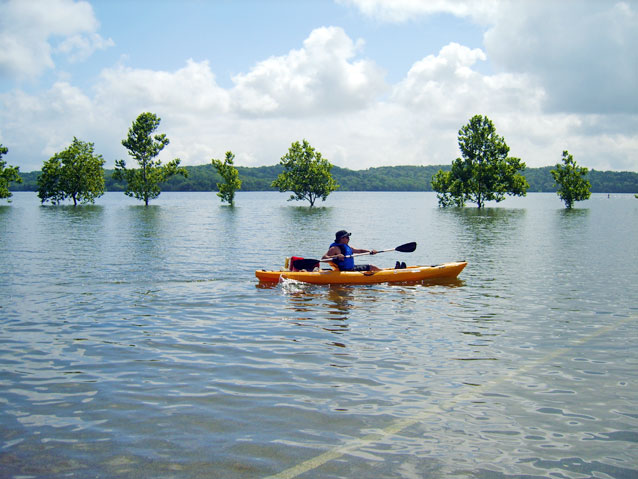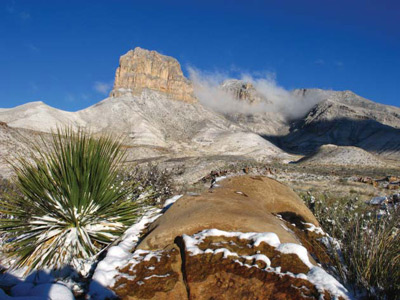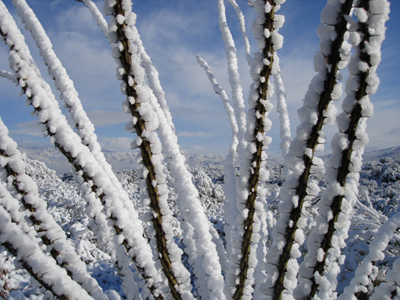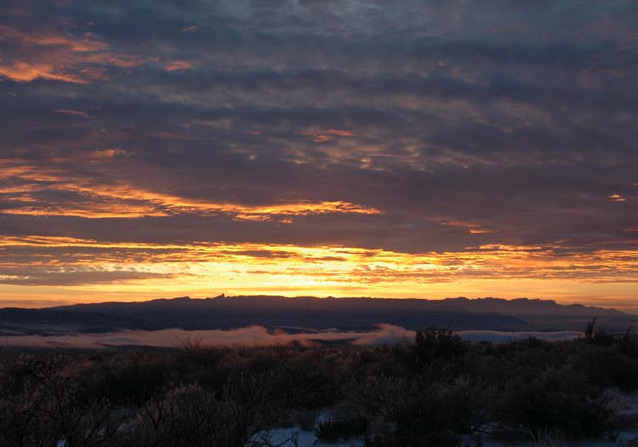Climate is one of many ecological indicators monitored by the National Park Service (NPS) Division of Inventory & Monitoring (I&M). Climate data help scientists to understand ecosystem processes and help to explain many of the patterns and trends observed in other natural-resource monitoring. In NPS units of the American Southwest, three I&M networks monitor climate using the scientific protocol described here.
Importance

NPS Photo
Our planet’s tilt and orbit around the sun result in uneven heating of Earth’s surface, generating global patterns of climate: temperature, wind, and precipitation. Collectively, these forces are primary drivers of ecosystem pattern and process. Climate in the American Southwest is characterized by mild winters, hot summers, and relatively low (but highly variable) precipitation. The region generally lies on the leeward side of the major North American mountain systems that block moist Pacific Ocean air masses, resulting in an arid and semi-arid “rainshadow” that distinguishes this region from more mesic areas.
Both El Niño Southern Oscillation (ENSO) variations and passages of tropical storm remnants affect interannual climate variations in the region, particularly precipitation. The southern Great Plains and Chihuahuan Desert are also greatly influenced by arctic air masses from the north and humid air masses to the east. The Sonoran Desert is characterized by a unique bimodal precipitation regime with intense localized thunderstorms during the summer monsoon season, and gentle, broad-scale winter rain and snow events. The influence of the summer moonson increases from west to east, such that summer rains are a critical component of Chihuahuan Desert ecosystems. In contrast to the relatively flat Great Plains, both the Chihuahuan and Sonoran deserts exhibit steep topographic gradients that exert powerful influences on local precipitation and microclimate. Examples of this influence include the high-elevation “sky island” systems that support flora and fauna generally only found at much higher latitudes.
Climate monitoring by the National Park Service (NPS) Southern Plains, Sonoran Desert, and Chihuahuan Desert networks supports a comprehensive understanding of ecosystem processes and serves as a key explanatory variable for many of the patterns and trends observed in other monitoring. The potential impacts of climate change on sensitive ecosystems, endemic species, and threatened or endangered species are of particular concern to national parks in these three networks.
Monitoring Objectives
Proposed specific, measurable objectives for climate monitoring are to:
- Determine annual status and detect long-term trends in precipitation and air temperature on a park-by-park basis. Evaluate these data relative to other vital signs in a covariate and data-exploration context to improve understanding of climate-driven patterns in monitoring information.
- Develop annual climate summaries on the network scale. These brief documents will support park management by summarizing available park data and placing it in broader spatio-temporal contexts.
Methods and Approach

Photo by Dustin Nelson, NPS
In most cases, the three networks will harvest basic climate data from existing weather stations established within or near network parks by the U.S. National Oceanic and Atmospheric Administration (NOAA) and the interagency Remote Automated Weather Station program. These data will typically have been processed by other entities, such as the Western Regional Climate Center and State Climatologist Offices, with a focus on index values, such as the Palmer Drought Index and related integrated values. We will also facilitate efforts by NOAA and others to upgrade existing cooperative observer stations and expand their networks to better cover climate conditions in network parks. An exception is the excellent park-operated weather station network at Organ Pipe Cactus National Monument, where core climate variables have been successfully monitored at several sites for more than 20 years. We will support park staff in data management, analysis, and reporting tasks for this unique climate monitoring system.
Products, Scope, and Schedule

Photo by Joshua Boles, NPS
Network-scale status and trends reports, and park-specific climate resource briefs, will be produced annually. The networks will rely on regional and national climate monitoring authorities (e.g., State Climatology Offices, Western Regional Climate Center) for identification and evaluation of potential regional climate trends.
Protocol Status

Photo by Eric Leonard, NPS
This protocol is currently in development. The protocol will rely heavily on the NPS Climate Monitoring Protocol for the Greater Yellowstone and Rocky Mountain networks. Protocol development summaries and climate inventory products are available on network websites. A database and supporting documentation that meet standards of the NPS and Federal Geographic Data Committee are complete for Sonoran Desert Network parks. Revisions to incorporate stations in and around Southern Plains and Chihuahuan Desert network parks is ongoing. Interactive climate data are available for all network parks.
Project Contact
Andy Hubbard, Sonoran Desert Network
e-mail us, 520-429-8147
Prepared by Andy Hubbard, Sonoran Desert Network, 2010.
Tags
- alibates flint quarries national monument
- amistad national recreation area
- bent's old fort national historic site
- big bend national park
- capulin volcano national monument
- carlsbad caverns national park
- casa grande ruins national monument
- chiricahua national monument
- coronado national memorial
- fort bowie national historic site
- fort davis national historic site
- fort larned national historic site
- fort union national monument
- gila cliff dwellings national monument
- guadalupe mountains national park
- lake meredith national recreation area
- lyndon b johnson national historical park
- montezuma castle national monument
- organ pipe cactus national monument
- pecos national historical park
- rio grande wild & scenic river
- saguaro national park
- sand creek massacre national historic site
- tonto national monument
- tumacácori national historical park
- tuzigoot national monument
- washita battlefield national historic site
- white sands national park
- swscience
- american southwest
- southern plains
- chihuahuan desert
- sonoran desert
- sodn
- chdn
- sopn
- climate change
- weather
- climate
- project
- science
- monitoring
Last updated: September 11, 2015
